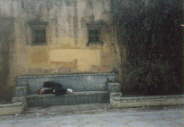| The branch, the room, the woman | 2 |

| ........................The room |
|
The room was rectangular and this did not vary with the days or the woman's visits. Sometimes he'd wake up at night and think he was somewhere else but always enough light seeped in through the window and the cracks around the door for lines slowly to emerge from the dark, and they were always straight and the angles always were in the same place. To the left, of course, stood the left-hand wall. All the walls were painted an even light-green color and the paint to his left was cracked under the molding that divided it from the ceiling. The crack had no particular shape; it was random. The molding had three shallow grooves cut longitudinally. These followed the molding, turning where it turned to follow the different walls without interruption. Close by his bed stood a white chipboard dresser with three drawers no one ever opened. The two top drawers had brass handles shaped like snakes. The bottom drawer bore no handles. Beyond the dresser stood the door through which the woman came and went. During the season of fuller light the branch's shadow started at the dresser and stretched to a place exactly between the door and the vertical crease marking the far left-hand corner of the room. At that crease the far wall started. It was the smallest of the three walls he could see. In the exact center a fireplace had been built into a thick chimney whose shape divided the wall into three rectangular planes. The chimney plane stood closer to him than the other two. That much he could tell from perspective. The fireplace had been walled up with concrete blocks. The mantelpiece was broad, of thick dark wood set into copious plaster, with curls and scrolls carved into the plaster's surface. Dust had collected like smiles in the lower arcs of ornamentation. Propped on the mantelpiece, leaning back against the rectangle of chimney, stood the mirror. It was plain, unframed. In front of the mirror stood the blue ceramic vase in which she placed cut flowers. The blue of the vase was a complex color; it seemed light and hard in the morning, but in the afternoon it included more green in its pigment and that green changed its appearance to something friable like chalk. This effect was more pronounced when she put light meadow flowers in the vase during the season of abundant light. With the darker, more solid blooms of other times of year, the blue in that vase did not vary as much. In the mirror he saw a reflection of the wall behind him. It seemed exactly like the wall in front except that it had no chimney. The mirror was set too high for him to see himself. Sometimes, when the woman stood upright beside him, stretching to relieve the ache in her back, he glimpsed, moving in the mirror's lower plane, the very top of the starched white thing she affixed into her hair with pins. The right-hand wall contained the window. It was very tall and side-hung; to open it, someone would have to twist the handle set into the vertical join in the middle, then pull both halves toward him into the room, so that the two sides opened, one right, one left, like the pages of a book. No one ever opened the window, so he could not be certain of this. The aperture was not complicated by curtains. There were four panes of glass in each side. The glass was uneven; the edge of bricks into which the casement had been set appeared to waver with impurities in the glass. Behind the window, just above the level of the handle, the branch itself stretched from a tree to the window's right, upward and toward the left. He could see nothing of the tree except for its branch. The branch never bore leaves or flowers yet it did not seem sick. Its bark was shiny and tight and either blue or purple or sometimes even pinkish depending on the light. Behind the branch, reaching perhaps a third of the way up the window's height, stood a brick wall, topped with a shelf of unadorned cement into which shards of glass had been set. The shards were of different colors; blue, green, brown. Some were clear, and often appeared white. Over the wall lay sky. The ceiling was painted white. It had cracks in it. One was in the shape of a bird with a very long beak and one wing. Another looked like the face of a leopard, only thinner than a real animal would be. Another didn't look like anything. Coincidentally, that one lay beside the crack in the left-hand wall that also resembled nothing. The floor was wooden and painted gray. The planks narrowed with perspective as they ran away from him, toward the fireplace and the far wall.
|
| Page 1 | Page 3 | Table of Contents |
| Tension | January 1997 |
 |